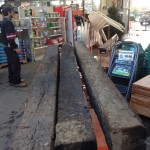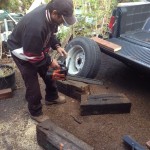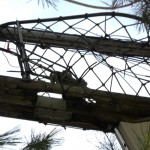Progress has been a bit slow as we had a general cleanup project for an property appraisal for a bank refinance, and we’ve been hampered by weather. Things should pick up a bit, however.
Next on the project list is to get the diesel fuel out of the tank. It’s clear that the tank is leaking. I pumped out the sump a couple of times last week, and each time the bilge slowly refilled with diesel after a couple days. Then there was the fiasco with the motor that required that I drain the engine pan, and that might as well go in the sump, too!
I bought six 5 gallon orange buckets at Home depot, for $3 each, and lids for $2, and a length of 25′ 1/2″ OD hose to extend the length of the fluid transfer pump I got at Harbor Freight some time ago. My plan is to use that to start a siphon with the buckets down at the ground level. That way I don’t have to carry buckets of sloshy oil up the companionway ladder, across the cockpit and down the 7′ ladder. We do learn – slowly but surely. I’ll need to take the plastic inspection port cover off so I can tell how much oil is actually there. Then I’ll need to see if the recycling center will take the stuff. If not we can maybe have a big bonfire for the 12/21/12 end of the world Mayan festivities.
This is a prelude to the tank removal, which is the big job for Nor’seas. Right now my interest is primarily in getting the stinky, flammable stuff out of my work environment.
Trailer Support
Another important task is getting the weight off the trailer wheels. I located some Railroad ties at a nearby Home Depot. They measure about 7×9″ x 8 feet, and weigh about 160 lbs each. I have some help coming Saturday to take this one on.
The reason for the supports: A Nor’sea weighs in the neighborhood of 5 tons, plus the 1500 lb trailer that’s a significant load on each wheel and sprung suspension member. Ed Zacko helpfully provided some very detailed guidance on the Yahoo Nor’sea 27 Forum in response to my inquiry on November 30th.
Items Required:
- some fresh 6×6 RR Ties(Home Depot) Use a chain saw to cut them to 2 ft lengths
- a few pieces of FRESH 2×4—-1 ft lengths and 4×4’s as “shims” support at incremental levels or jack re-sets.
- two planks—we used 2×8’s—-to spread the load over a wide area—If you dont do this the Blocks will sink into the ground —almost immediately and you may not be able to remove the jack. — also–if you are on black top over time they will also want to sink in and ruin the black top.
Warnings
- choose a location that is not on top of submerged sewer lines, pipes, gas pipes, water Pipes etc.
- DO NOT use Cinder Blocks or Concrete blocks for this—they will crack and fail!
- DO NOT try to get a wheel off the ground in one go—you can put a lot of strain on the trailer and the hull—Take it easy and be patient.
- Jack up each wheel along the axle—as close to the spring as you can get–then add the blocks and lower GENTLY
Instructions:
- We always stored Entr’acte at 6 points. The trailer will be fine and stable and safe to store for long periods and also to work under.
- You will have blocks on all 4 (6) wheels.
- Block it up high enough so that the wheels can spin–that way you can easily remove the tires to service the brakes etc—The boat will settle over time—the planks will sink a bit and the wood will compress—especially over a long time.
We had a few pieces of steel “I” beam that we put down first then set the RR Ties into those—but 2×8 work just as well.
- Add some blocks under the front of the trailer–just behind the brake actuator and also in the center of the last cross brace at the rear of the trailer—It’s amazing what can happen when one or two people go aft to do something—“Hey–hand me that sander–” and they step back to give it to you—-WATCH OUT for that.
- When you start to jack up you will realize just how heavy the NorSea is. You will have to go-incrementally from wheel to wheel–and remove the jack to re-set it—that’s why you have blocks of different thickness. Eventually you will get her where you want her.
- The first time you try this it takes some time and you have to be creative with the blocks and the screw out head of the jack. Do it wrong and you can’t get it high enough to put in a block and you can’t extract the jack—Over the years I got to know the process so well that I could actually get her up in less than an hour.
- In many ways it’s like raising your mast—you crank for a LONG time and it looks like it ain’t going anywhere—it just moves by mllimeters until you get it going
- Throughout the jacking process be prepared for a lot of creaking and groaning as you jack and also for a lot of crackling as the wood compresses. That’s why you want to use NEW wood and not some old stuff you have lying around—also the RR Ties are quite dense compared to other wood. It’s a bit disconcerting the first time you do it.
Take it easy –take it slow. Ed Zacko




